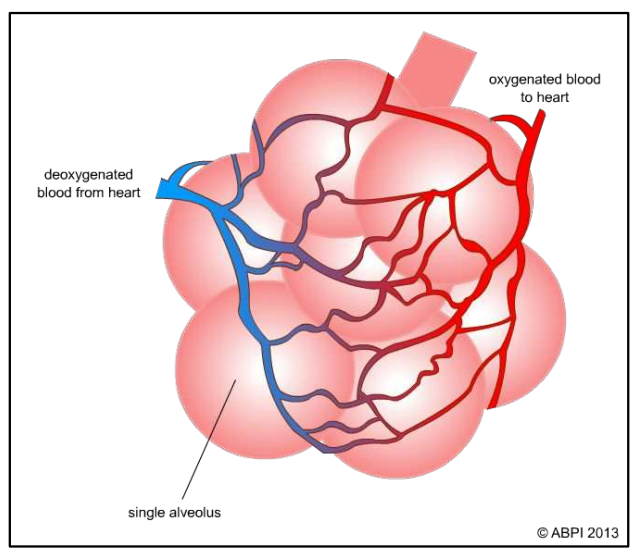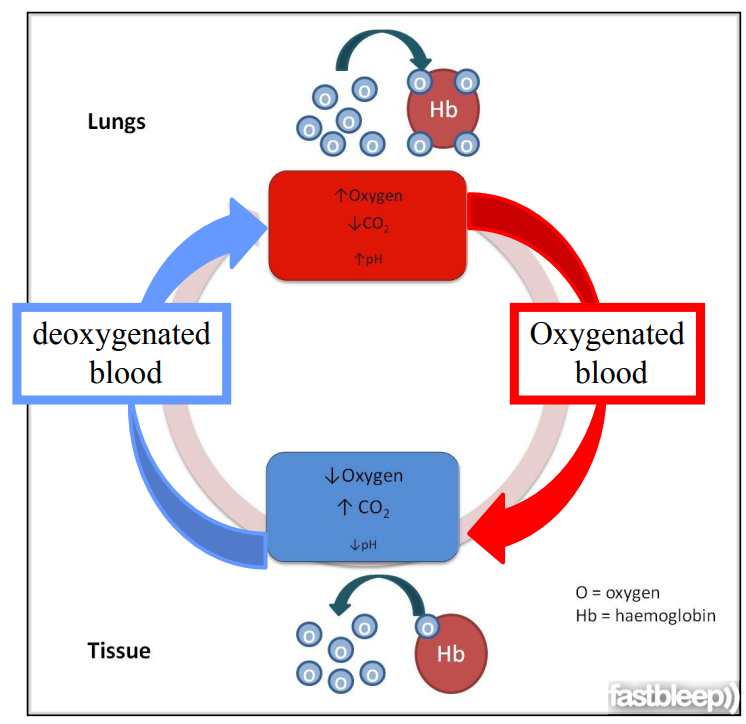- IB DP Biology 2025 SL- IB Style Practice Questions with Answer-Topic Wise-Paper 1
- IB DP Biology 2025 HL- IB Style Practice Questions with Answer-Topic Wise-Paper 1
- IB DP Biology 2025 SL- IB Style Practice Questions with Answer-Topic Wise-Paper 2
- IB DP Biology 2025 HL- IB Style Practice Questions with Answer-Topic Wise-Paper 2
B3.1.1—Gas exchange as a vital function in all organisms
All organisms respire
Cell respiration releases energy, needed for cell activities movement, beating of heart and breathing movements.

Oxygen + Glucose needed to release energy
Respiration that needs oxygen = aerobic respiration

Gas exchange: 1. Getting oxygen from environment
2. Releasing CO2 to environment
Gas exchanges occur by diffusion across cell membrane
Gas Exchange Surface = Surface of the organism dedicated to gas exchanges.
Plants respire, photosynthesize and transpire
Cell respiration releases energy, needed for cell activities
Respiration that needs oxygen = aerobic respiration
Photosynthesis produces organic molecules

Transpiration = loss of water vapour through leaves
Gas exchanges occur by diffusion across cell membrane
Gas Exchange Surface = Surface of the organism dedicated to gas exchanges


If cell size increases, The distance from the centre of cell to its exterior increases , which implies, Exchanges with environment become more challenging

Why the need for a gas exchange system inside large organisms ?




Small organisms have a large SA/V ratio \(\Rightarrow\) Cells directly in contact with environment
\(\Rightarrow\) Can exchange gases easily with environment

Bigger organisms have a small SA/V ratio \(\Rightarrow\) Cells mostly very far from environment
\(\Rightarrow\) Cannot exchange gases easily with environment \(\Rightarrow\) To exchange enough gases
Oxygen from environment to the respiring cells
CO2 from the respiring cells \(\Rightarrow\) Need a gas exchange system inside the body



B3.1.2—Properties of gas-exchange surfaces
GES used for Respiration in all organisms
Respiration, Photosynthesis and Transpiration in Plants

Adaptation of mammalian lungs for gas exchange
Thin tissue layer
Thickness of surface = distance that gases have to cover during gas exchange
The thinner the distance, the more efficient the gas exchange \(\Rightarrow\) Gas exchange surfaces are THIN.


Adaptation of mammalian lungs for gas exchange
Permeability

B3.1.3—Maintenance of concentration gradients at exchange surfaces in animals
Adaptation of mammalian lungs for gas exchange
Maintenance of concentration gradients
Oxygen and carbon dioxide diffuse down their own concentration gradient
The steeper the concentration gradient, the faster the diffusion
Constant ventilation + constant flow of blood maintain these concentration gradients


B3.1.4—Adaptations of mammalian lungs for gas exchange
The respiratory system in humans


Internal / External intercostal muscles

Cartilage in trachea

The Lower Respiratory Tract

1. Trachea (the windpipe)
- 16-20 C-shaped rings of cartilage
- joined by fibroelastic connective tissue
- Flexible for bending
- But stays open during breathing
2. Trachea divides into two
- primary bronchi (bronchus if singular)
- Enter the lungs
3. Bronchi divide into bronchioles
- End in alveolar sacs
- Bronchi and largest bronchioles have cartilage rings too
4. Alveolar sacs are made of alveoli
- (alveolus if singular)
- Gas exchanges between air and blood
- 300 million per human lung
Mucus in trachea and bronchi/bronchioles

Mucus produced by goblet cells
Traps bacteria, spores of fungi, viruses, dust…
Ciliated cells beat their cilia
Move up mucus towards back of the mouth
Mucus swallowed into stomach
pH 2 and HCl kills them all
B3.1.2—Properties of gas-exchange surfaces
B3.1.4—Adaptations of mammalian lungs for gas exchange

Alveoli have a large surface area to volume ratio

Exchanges of gases between blood and alveoli air

Alveoli have a large surface area in contact with blood vessels for exchanges of gases
600 million of alveoli total 70\(m^2\) = 35 X skin surface = a badminton court
Adaptation of mammalian lungs for gas exchange
Moisture
Land organisms:
Gas exchanges between atmosphere and watery inside of organism
Circulation can only transport liquid and their solutes
Gases from/to atmosphere have to be dissolved before diffusion can occur
Gas exchange surfaces are MOIST
Gas will dissolve in this moistness,
` THEN diffuse in/out

Aquatic organisms:
Gas exchanges between watery environment and watery inside of organism
Gases from/to environment are already dissolved
Diffusion can occur directly
Type I & II Pneumocytes

Type I
• Adapted to carry out gas exchange
• Large total surface area for diffusion
• Make up majority of epithelial cells lining the alveoli
• Flattened cells
Type II
• Secrete a solution containing a surfactant creating a moist surface preventing cell adherence
• Moisture allows oxygen and carbon dioxide to dissolve then diffuse
• Rounded cells
B3.1.5—Ventilation of the lungs
Breathing out = expiration = exhalation
+
Breathing in = inspiration = inhalation
=
Ventilation
i.e. “making wind”
Replacement of air in alveoli to:
– Bring in air rich in oxygen
– Get out air rich in carbon dioxide
\(O_2\) is needed for cell respiration: has to be taken from the air
We breathe in to get oxygen from the air
\(CO_2\) is a metabolic waste produced by cell respiration: has to be gotten rid of
We breathe out to get rid of carbon dioxide

Breathing in = Inspiration = Inhalation

Breathing out = Expiration = Exhalation


A2.2.2—B3.1.6—Measurement of lung volumes
Application of skills: Students should make measurements to determine tidal volume, vital capacity, and inspiratory and expiratory reserves.

B3.1.7—Adaptations for gas exchange in leaves






• Allow sufficient water to reach the cells in the leaf
• To carry food away to other parts of the plant

- Stomata (sing. stoma ) = pores in a leaf, mostly on the undersurface
- Each pore is surrounded by a pair of guard cells
- Guard cells can change shape to open or close the stoma
How Guard cells work
- Guard are the only epidermal cells with chloroplasts
- In daylight when the stomata opens so \(CO_2\) can enter leaf:
- Chloroplasts make sugars (photosynthesis)
- Guard cells actively pump in \(K^{+}\) ions.

B3.1.8—Distribution of tissues in a leaf
Anatomy of a leaf



Cuticle:
• a waxy layer
• prevents water loss from the leaf surface

Upper epidermis:
Protects internal tissues from
1. Mechanical damage
2. And bacterial & fungal invasion
3. Water loss


Columnar cells closely packed together absorb light more efficiently



Opening which allows gases to pass through it to go into or out of the leaf



B3.1.9—Transpiration as a consequence of gas exchange in a leaf
Factors affecting transpiration in a leaf
Transpiration occurs through the stomata
Stomata open only if there under light
1. Transpiration happens mostly in daylight
2. At night, less water is lost by transpiration
Reduce water loss = Avoid wilting
- 98% of water entering leaves is lost to the air by transpiration


- Transpiration only occurs if Ψ air > Ψ air space in leaf
- Transpiration only occurs if Ψ air > Ψ air space in leaf
The warmer the air,
The higher its Ψ - Wind moves away the air that has received water vapour from leaf


Hard to measure water vapour loss
Measure water absorbed by roots
- Xerophytes
Xero = dryphuton = plant - Halophytes
Halo = saltphuton = plant

B3.1.10—Stomatal density
Application of skills: Students should use micrographs or perform leaf casts to determine stomatal density.

B3.1.11—Adaptations of foetal and adult haemoglobin for the transport of oxygen
In oxygen dissociation curves of haemoglobin,
- What does a left shift mean?
- What does a right shift mean?

How can we explain these differences?




B3.1.12—Bohr shift


B3.1.13—Oxygen dissociation curves as a means of representing the affinity of haemoglobin for oxygen at different oxygen concentrations
Red blood cells, haemoglobin and oxygen transport
Red blood cells bind, transport then release oxygen thanks to the protein Hemoglobin


Lungs
Blood needs to take up O2
Hb + O2
gives HbO2 Oxyhaemoglobin
High partial Pressure O2
High affinity of Hb for O2
Maximum take up O2 from air
Respiring tissues
Blood needs to release O2
HbO2 gives Hb + O2 Deoxyhaemoglobin
Low partial Pressure O2
Low affinity of Hb for O2
Maximum release O2 to tissues

Haemoglobin structure
Haemoglobin = Respiratory pigment

Haemoglobin has quaternary structure
Four subunits
Two alpha chains
Two beta chains
Each contains a haeme group that can bind oxygen
Haemoglobin binding oxygen


Haemoglobin dissociation curve

Lungs
Hb + O2 gives HbO2 Oxyhaemoglobin
Highest partial Pressure O2
Highest affinity of Hb for O2
Maximum take up O2 from air
Cooperative binding affected by oxygen concentration \(\Rightarrow\) Curve is sigmoid
Respiring tissues
HbO2 gives Hb + O2 Deoxyhaemoglobin
Lowest partial Pressure O2
Lowest affinity of Hb for O2
Maximum release O2 to tissues